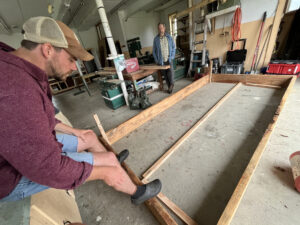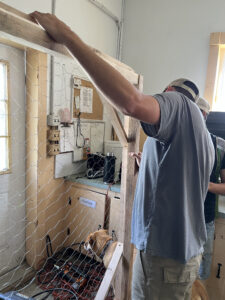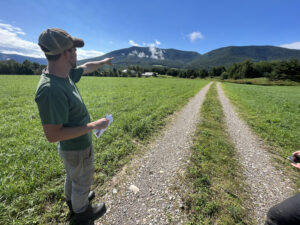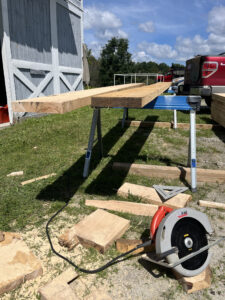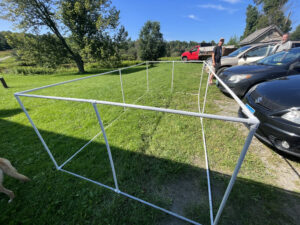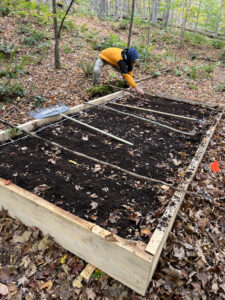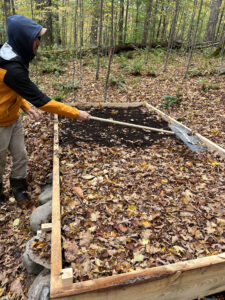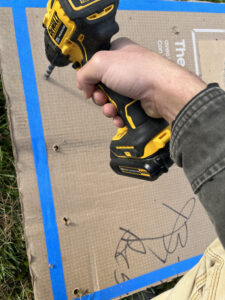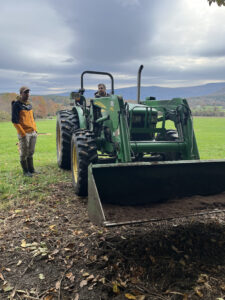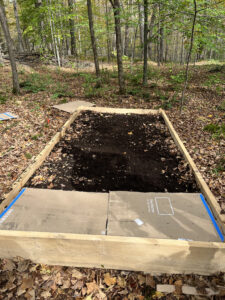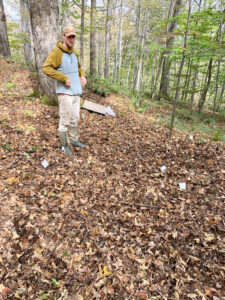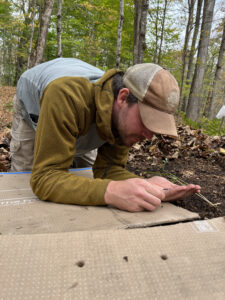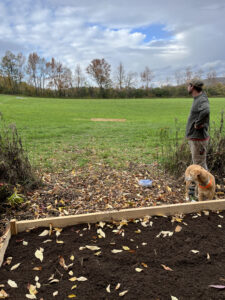Progress report for LNE23-469
Project Information
Forest farming—the cultivation of crops under a forest canopy—is an agroforestry practice that represents a significant economic opportunity for farmers, forestland owners, and land stewards in the Northeast. Forest farming is gaining traction in the region, in part due to initiatives like the Northeast Forest Farmers Coalition and in part due to the benefits derived from forest farming: diversified income, farm resiliency, protection of forestland, and increased understory biodiversity (Chittum et al., 2019). With growing numbers of BIPOC land stewards engaged in regenerative land management practices regionally, forest farming also represents an opportunity to counteract the systematic marginalization of these groups.
However, for farmers with access to forest land, there are two major barriers inhibiting adoption of forest farming in the Northeast:
- major shortages in forest botanical planting stock (seeds and roots)
- low price points in wholesale markets do not currently support forest farming operations
This lack of planting stock is inhibiting beginning forest farmers from starting their own enterprises. Additionally, mature roots being sold wholesale into medicinal markets fetch only one tenth the price of roots being sold as planting stock (Felumlee, 2021). Together, these barriers are stagnating the growth of a healthy regional forest farming industry.
We propose a 3-pronged approach to simultaneously solving these issues by equitably increasing planting stock in the region. Project initiatives include:
- Increase Propagation Know-How: Launch an educational campaign based around development of a Research and Demonstration Nursery (R&D Nursery), on-farm workshops, and online educational materials that promote sound forest botanical propagation techniques. Research will provide empirical data supporting existing farmer knowledge of four successful propagation techniques used for commercially valuable forest botanical species.
- Equitably Distribute Local Seed Stock: Establish regional seed exchange network that connects seed collectors to forest farmers interested in buying seed as well as working to gain seed collection rights on private lands for BIPOC land stewards.
- Increase Available Root Stock: Establish a Forest Grown Verification Program and pilot a plant rescue program that channels sustainably harvested wild roots to be sold locally as planting stock, rather than into wholesale markets.
All of these initiatives will prioritize working with BIPOC farmers and other historically marginalized groups. These efforts will jumpstart a new regional forest botanical propagation economy where forest farmers and land stewards provide sustainably sourced and genetically-diverse planting stock to forest farmers, in turn removing the biggest bottleneck to forest farming adoption. Additionally, forest farmers and land stewards will access an entirely new planting stock market that provides higher price points and shorter harvesting intervals compared to wholesale markets. In total, this project will benefit up to 1,000 small and mid-sized farms and forested properties, plant nurseries, and wild-harvesters.
1.1 10 independent forest botanical propagation enterprises will be established.On existing farms. These operations will benefit farmers by diversifying crops and income streams by expanding markets for farmers.
1.2. Propagule exchange program will link 25 seed/plant collectors to a diverse group of 100 propagators/forest farmers
The project addresses the critical shortage of forest botanical planting stock, which hampers the expansion of forest farming in the Northeast. Identified by the Northeast Forest Farmers Coalition, this shortage impedes local sourcing of key botanicals like ginseng and goldenseal. The proposal outlines a three-pronged strategy focusing on increasing propagation know-how, equitably distributing local seed stock, and enhancing available rootstock through workshops, online resources, and collaboration with forest farmers. This approach aims to support BIPOC farmers and address the economic and environmental sustainability challenges in the region, thereby fostering a new propagation economy and overcoming barriers to forest farming adoption.
Research
Our research will examine a suite of four common approaches to forest botanical propagation along a scale of “intensity,” providing data to develop species-specific best growing and transplanting practices. We will 1) quantify outcomes (germination, growth, and survivorship) across these four approaches and 2) track and quantify the profit margins (cost vs. revenue) by species for each approach. Our findings will provide data to support species-specific and approach-specific best practices, relevant to a wide range of forest farmers. Rather than building toward a single, best approach, we expect our research to support the increased efficiency of a range of approaches.
Successful and efficient plant propagation is a significant bottleneck in the forest botanical supply chain. Increasing the supply of key species is an effort best undertaken at varying levels of scale and intensity. Yet key information is lacking at both the species level and the system level for most commercially valuable understory species. This decreases efficiencies within propagation systems, be it in a greenhouse or a woodland planting.
If someone plans to grow goldenseal from seed in their woods and subdive the roots to sell as planting stock, what is the optimal light level? Does that change in a greenhouse? Does it change when you are growing bloodroot? Do species-specific market prices change what degree of input variation is cost-effective? And, critically, do different propagation methods affect success when transplanting plants into a forest?
With these types of questions as framing, our research will track outcomes and cost ratios across four common propagation systems for six commercially significant forest botanical species: ramps, Solomon’s seal, goldenseal, black cohosh, bloodroot, and American ginseng.
Our research plan consists of two phases:
- Phase 1: Growing
- Phase 2: Transplanting
Treatments:
Our four treatments will each represent a distinct propagation system already utilized by forest farmers, and are as follows: A) greenhouse, B) forest edge, C) forest beds, and D) forest understory. These treatments have been chosen based on 1) key personnel experience, 2) direct farmer input via formal and informal interviews, 3) a review of the existing scientific literature, and 4) discussions with propagation experts (researchers and nursery owners) regarding the most common and cost-effective propagation techniques.
- Greenhouse: Plant stratified seed under a high tunnel into raised beds lined with landscape fabric and filled with potting soil. Water periodically and grow for two years.
- Forest Edge: Plant stratified seed into raised beds lined with landscape fabric filled with potting soil and placed in a field along a forest edge under shade cloth. Raised beds will be covered in chicken wire to reduce predator impacts. Water periodically and grow for two years.
- Forest Beds: Plant stratified seed into raised beds lined with landscape fabric filled with potting soil and placed under forest canopy. Raised beds will be covered in chicken wire to reduce predator impacts. Water periodically and grow for two years.
- Forest Understory: Plant stratified seed into tilled rows under forest canopy. Water periodically and grow for two years.
We will compare whether treatments with higher material and up-front costs (A and B) result in higher survival than treatments with lower material and up-front costs (C and D), and–given that all of these approaches are being trialed across the Northeast–will ask: what economic (e.g. prices points) and ecological conditions (e.g. germination and survival rates) are required to make each of the four propagation systems profitable?
Methods
Experimental design: Our research site will be located within a half-acre area located on property owned by the Smokey House Center in Danby, VT. Treatments A (Greenhouse), B (Forest Edge), and C (Forest Beds) will be grown out in predator-controlled 5x10 foot raised beds. Treatment D (Forest Understory)––will have no predator control. Each of the six species will be planted in all four treatment areas. In Treatment A, plantings will be placed in a greenhouse in 5x10 foot raised beds. In Treatment B, plantings will be placed in an open field setting along the edge of a forest, in 5x10 foot raised beds shielded from direct sunlight with shade cloth. For Treatment C, plantings will be under a forest canopy, in 5x10 foot raised beds. And in Treatment D seeds will be sown directly into the forest understory of a second growth mixed hardwood forest.
For each treatment, 200 seeds will be planted 3 inches apart to avoid seedling competition. Seeds will be planted in November of 2023 to align with the natural seedset for the project species. All outdoor treatments will be surrounded in chicken wire above ground and landscape cloth below ground to avoid predation from birds, deer, and voles. Seeds will lay dormant until the spring after which periodic watering will occur to maintain a consistent soil moisture. Treatments will grow and be monitored for two growing seasons (Phase 1, through the fall of 2025) before being dug up, weighed, and replanted in a wild-simulated forest farming setting at the Smokey House Center in Danby, VT (Phase 2, initiated fall 2025).
Within each treatment, plantings will be organized by species, with inputs (sunlight, growing medium, moisture, fertilizer) tailored to species-specific needs. For example, the research suggests that ginseng seedlings grow fastest with access to 36% light (Proctor and Palmer 2017) while black cohosh grows rapidly with access to full sun (Davis 2019). With a goal of producing species-specific recommendations and best practices, the primary focus of analysis will be within species and between treatments.
Data Collection and Analysis:
Phase 1: Initial seed germination data will be collected in the spring of 2024. In the fall of 2024 survivorship and growth after one growing season will be noted. We will continue to track emergence, establishment, and survival in year two.
Phase 2: After two growing seasons, plants will be transplanted into a wild-simulated forest farming setting at the Smokey House Center to replicate the process of plants being sold as planting stock. Individual plants will be weighed, and labeled based on treatment and planted in a replicated pattern across the landscape to reduce site bias. These plants will be left to go dormant over the winter of 2025 before individual transplant survival and growth (positive and negative) are measured during the summer of 2026. This second phase of the research trials will provide critical information on the variation in transplant success between propagation methods, with an expectation that more intensive cultivation methods will lead to higher levels of transplant shock (e.g. low/negative growth rates, death).
Once all the Phase 1 data has been compiled, in order to analyze differences between treatments, we would conduct two-way ANOVAs, examining the effects of differing light, moisture, and nutrient levels between treatments on response variables (e.g. seed survival and annual growth) within each species. We would also run univariate regressions between individual variables (e.g.light, moisture) on survival and growth to determine which variables are having the biggest effect on our response variables. Phase 2 data would allow us to establish a relationship between species, propagation method (our treatments) and transplant success.
Throughout the duration of the project we will track costs associated with each treatment, which, along with survival, growth and yield data will allow us to conduct species- and treatment-specific profitability analyses.
Farmer Input:
Forest farmers and understory plant propagators were consulted throughout the research design process. We conducted surveys through the NFFC’s landowner network, in which farmers spoke of their interest in growing and selling understory herbs as planting stock to other forest farmers in the region, also indicating an interest in learning about the most efficient propagation methods.
We also conducted conversations with forest botanical plant propagation experts, including Margaret Bloomquiest of NC State (and the ABFFC) and Tanner Filyaw of United Plant Savers, which provided critical insight into the gaps in our understanding of species-specific propagation best practices.
Year 1 update
All research sites were established at Smokey House in the fall of 2023, including building of planting bed infrastructure and seeding all sites with plants. Project leaders consulted extensively with faculty at the Yale School of the Environment, including project PI Dr. Marlyse Duguid and Karam's PhD advisor Dr. Mark Bradford, on research design. A soil mix for our raised beds was designed with the Vermont Compost Company, delivered by truck, and moved into beds with the help of volunteers. Beds were designed and constructed by Smokey House staff and project leaders, moved into the field and filled with soil by Smokey House staff, and planted by project leaders Karam and Walker.
Year 2 update
During the spring and summer of 2024 we conducted an initial round of data collection on our propagation beds, along with periodic weeding. Of the species we planted via seed into our beds, ginseng was the only seed that was stratified and thus the only species that emerged the season after planting. We noted Year 1 germination rates in each bed; in Spring 2025 we will conduct another round of data collection and expect to get germination rates for the the other five species we planted as well as establishment data for the ginseng.
Education
Engagement
We will recruit grant participants by collaborating with partner organizations like the NFFC, Smokey House Center, United Plant Savers, and Soul Fire Farm, as well as with groups like the Northeast Farmers of Color Land Trust, Southern New England Farmers of Color Collaborative, Black Farmer Fund, and regional indigenous tribes to recruit historically disadvantaged BIPOC participants. Wild harvesters will be recruited by sending out calls over social media networks like Facebook, which are the primary communication platforms for many wild harvesters.
A cohort of 10 beginning propagators (at least 4 of which will be BIPOC) will be recruited in year one of the grant to start new forest botanical propagation enterprises. Cohort will receive technical support for the entirety of the grant and have access to annual opportunities to apply for stipends up to $1,000 to cover start-up costs for propagation enterprises.
To gain commitment from cohorts of seed collectors and root wild harvesters (25 and 10, respectively), we will provide educational resources around best harvesting practices as well as access to new markets through the seed exchange network and the NFFC forest farming community. In addition to the cohort of 45 participants, educational workshops, online content, and technical support will be available to anyone in the Northeast.
Learning:
Phase One: Build cohorts and distribute existing educational resources
Identify 10 participant beginning propagators. Distribute existing educational resources on propagation and provide technical support to these participants. Pay expert propagators to provide one-on-one knowledge sharing and operational troubleshooting to beginning propagators. Beginning propagators will have the option to apply to receive farmer stipends of up to $1,000 to cover material costs (seed, shade cloth, raised bed materials, etc.) of beginning propagation enterprise.
Identify a diverse group of 25 seed collectors. Distribute existing educational resources around sustainable harvesting practices to both groups.
Phase Two: Produce video series and conduct workshops and trainings
Produce series of educational videos on propagation, seed collection, and harvesting best practices for woodland botanical species. These resources will be informed by interviews with expert propagators and forest farmers. Videos will be freely distributed across the vast networks of the NFFC and ABFFC (3000 members combined, Forest Farming Youtube Channel has over 24,000 subscribers) educating thousands of people on the propagation of woodland botanicals.
Conduct 3 regional field-based trainings focused on sustainable seed collection techniques for forest botanicals led by expert seed collectors. Trainings will be free to the public.
Enroll and train Forest Grown Verified (FGV) Certifiers through program that is currently being developed by project partners in Appalachia.
Lead 6 propagation workshops regionally in collaboration with project partners and 10 participating beginning propagators. Workshops will reach 120 potential propagators/forest farmers. Topics will range from cost-effective propagation techniques to demonstrations of building nursery beds to business planning your nursery operation. Planting materials grown at R&D Propagation Nursery will be given away to workshop attendees.
Phase Three: Launch marketplace opportunities
Launch marketing campaign that increases awareness amongst forest farmers and seed collectors of new and existing seed exchange networks housed in the region.
Phase Four: Present grant findings
We will publish a user-friendly manual on forest botanical propagation informed by our research findings which will be distributed and presented at regional conferences. Conference presentations will focus on both findings from applied research conducted at R&D Propagation Nursery.
Evaluation:
Project success will be monitored and evaluated through annual surveys distributed across NFFC’s and other partner’s networks. These surveys will focus on quantifying farmer adoption of the practices promoted through the grant as well as any shifts of perception around the problems being addressed by the grant.
Workshop attendees will receive both pre-workshop and post-workshop surveys to track learning and acquire feedback. Feedback will be incorporated into future learning events to assure that grant content is continuing to be curated to the needs of practitioners. Distribution and reach of online content will be tracked through web page views and video views.
We will work with the Educational Assessment Specialist at Yale’s Poorvu Center for Teaching and Learning to assure that the grant metrics are being properly tracked and verified.
Year 1 update
Project leaders have begun conversations with expert propagators and built recruiting materials for our beginning propagator cohort. We are scheduled to host a strategic session on the project--sharing plans and soliciting input--at the upcoming Gather to Grow conference in March 2024.
Year 2 update
We've made significant progress toward our educational goals. We successfully recruited a diverse group 10 farmers from across the Northeast region into our propagation cohort. We have held significant programming for the cohort, including a launch event featuring a workshop led by expert propagator Margaret Bloomquist of North Carolina State University; we assembled cohort members at the inaugural 2024 Northeast Forest Farming Conference at the Smokey House Center in Danby, Vermont, the capstone event to end SARE project LNE21-423, so that everyone could meet in person, and ran a series of workshops and tours including a tour of the propagation research beds set up through this project and an in-depth presentation on forest botanical propagation systems for the group; at the conference, we held a number of propagation sessions specifically tailored to support our propagation cohort in launching their enterprises; we have held recurring office hours twice a month and used that time to answer specific questions from cohort members; we have had two round of virtual presentations from cohort members to share their progress toward project deliverables; we have sent resources to cohort members, including instructional books on propagating forest botanicals, an initial round of planting stock to each cohort member to jumpstart their operations, and stipends for cohort members to put toward buying planting stock and building infrastructure; we have conducted site visits for the majority of cohort members and are scheduling the remaining visits for Spring 2025; and we have provided letters of support on two farmer grants from cohort members to help them expand their propagation enterprises.
In addition to cohort-specific activities, we have hosted three public-facing propagation workshops, representing significant progress toward project deliverables.
Milestones
Milestone #1: “Engagement”
What farmers learn or do: 10 beginning propagators and 25 seed/propagule collectors receive invitations to participate in the program. Participants will learn about grant activities and how they can get involved. Participants will also be connected with greater regional forest farming community members through the Northeast Forest Farmers
Coalition. Proposed number of farmers: 10 beginning propagators, 25 seed/propagule collectors (Completed by March 1, 2024)
Year 1 update
Project leaders have begun the recruiting process and are on track to assemble a cohort by March 1st, 2024.
Year 2 update
Our propagation cohort has been assembled and is moving through an educational curriculum; cohort members are on track to have nursery infrastructure established and plants in the ground in the Spring 2025.
Milestone #2: “Learning”
What farmers learn or do: Grant participants, as well as general public, receive access to curated collection of existing published resources on woodland botanical propagation, seed collection and sustainable root harvesting including publications from agricultural extension agencies, expert propagators, and videos already on the Forest Farming Youtube Channel and distribute to grant participants. These resources will also be published for public use on the NFFC’s “Resources” web page.
Proposed number of farmers: 35 grant participants plus 250+ web viewers (Completed by March 1, 2024)
Year 1 update
Project leaders are assembling resources and are on track to share these out by March 1st.
Milestone #3: “Learning”
What farmers learn or do: Participating seed/propagule collectors receive and watch video series describing sustainable seed/propagule collection techniques. This content will also be available to the public via the NFFC website and Forest Farming Youtube Channel.
Proposed number of farmers: 25 participating seed collectors plus 2,000+ viewers on Forest Farming Youtube Channel (Completed by September 1st, 2024)
Year 2 update
Videos have been uploaded to YouTube, shared with the propagation cohort, and have received thousands of views.
Milestone #4: “Learning”
What farmers learn or do: Participating beginning propagators receive and watch video series describing best propagation practices for forest botanical species in focus. Content is also available to the public via the NFFC website and Forest Farming Youtube Channel. Content will be supplemented by existing resources on forest botanical publications.
Proposed number of farmers: 10 participating beginning propagators plus 2,000+ from Forest Farming Youtube Channel (Completed by July 30th, 2026)
Year 2 update
We have uploaded a video series onto YouTube and have additional videos in the pipeline being created, all focused on propagation techniques.
Milestone #5: “Engagement”
What farmers learn or do: Seed/propagule collectors receive invitation to join seed exchange program on NFFC’s website where they can sell planting stock to forest farmers in need of forest botanical seeds and roots.
Proposed number of farmers: At a minimum 25 seed collectors selling seed and 50 forest farmers buying seed. (Completed by September 1st, 2024)
Year 2 update
We have conducted a number of seed exchange events, including at project workshops and at the 2024 Northeast Forest Farming conference. Over the course of the project we have started engaging in dialogue with state botanists and forest conservation specialists in states across the Northeast around seed exchange. One result of these conversations has been a deeper dive into seed exchange activities – we are currently moving in the direction of a model that would partner with existing seed saving entities in the Northeast, such as The Native Plant Trust, rather than creating our own network; we belief this will result in partnerships that do more to advance the goals of the project. This hasn't stopped progress on project deliverables, and we've facilitated the exchange of seed between over 150 growers in the Northeast as of the end of Project Year 2.
Milestone #6: “Learning”
What farmers learn or do: Beginning seed collectors will be trained during 3 regional field-based trainings focused on sustainable seed collection techniques for forest botanicals led by expert seed collectors. Trainings will be free and open to the public.
Proposed number of farmers: 60 (20 per training) (Completed by July 30th, 2026)
Milestone #7: “Learning”
What farmers learn or do: Beginning propagators will be trained during six educational workshops showcasing best propagation practices that will be housed at R&D Propagation Nursery as well as throughout Northeast in collaboration with regional partners and 10 beginning propagators. These workshops will be free to the public. Pilot plant rescue program at one site in the region.
Proposed number of farmers: 120 (20 per workshop) (Completed by July 30th, 2026)
Milestone #8: “Learning”
What farmers learn or do: Participating beginning propagators, seed/propagule collectors have the opportunity to get one-on-one technical support from experts. Grant will pay experts for their mentorship. Additionally, beginning propagators will have the opportunity to apply for stipends of up to $1,000 that will cover start-up costs of new propagation enterprises.
Proposed number of farmers: 45 (10 beginning propagators and 25 seed collectors) (Completed by July 30th, 2026)
Year 2 update
We have conducted site visits for beginning propagators and have begun dispersing stipends to propagation cohort members, as well as providing guidance on the infrastructure investments made with these funds.
Milestone #9: “Evaluation”
What farmers learn or do: Regional farmers receive an invitation to provide feedback through an annual online survey distributed through NFFC and other partner networks. This will be an opportunity for project leaders to hear and incorporate annual feedback as well as collect data on grant progress.
Proposed number of farmers: 100 (Completed by July 30th, 2026)
Milestone #10: “Learning”
What farmers learn or do: Broader forest farming community receives access to user-friendly manual of best forest botanical propagation practices published by project leaders and distributed through partner networks. Manual will include cost analysis of each of the four treatments explored in research.
Proposed number of farmers: 1,000 readers (Completed by July 30th, 2026)
Milestone #11: “Evaluation”
What farmers learn or do: Project leaders present grant findings in collaboration with select grant participants (beginning propagators, seed collectors, and Forest Grown Verified Certifiers) at regional conferences such as Society of American Foresters National Conference, and state NOFA conferences. This will serve as an opportunity to hear feedback and responses from broader academic and professional communities on the success of the project.
Proposed number of farmers: 3-6 (Completed by July 30th, 2026)
Performance Target Outcomes
Target #1
10
Farmers will establish independent forest botanical propagation enterprises on their existing farms.
These operations will benefit farmers by diversifying crops and income streams by expanding markets for farmers. The propagule exchange program will link 25 seed/plant collectors to a diverse group of 100 propagators/forest farmers
